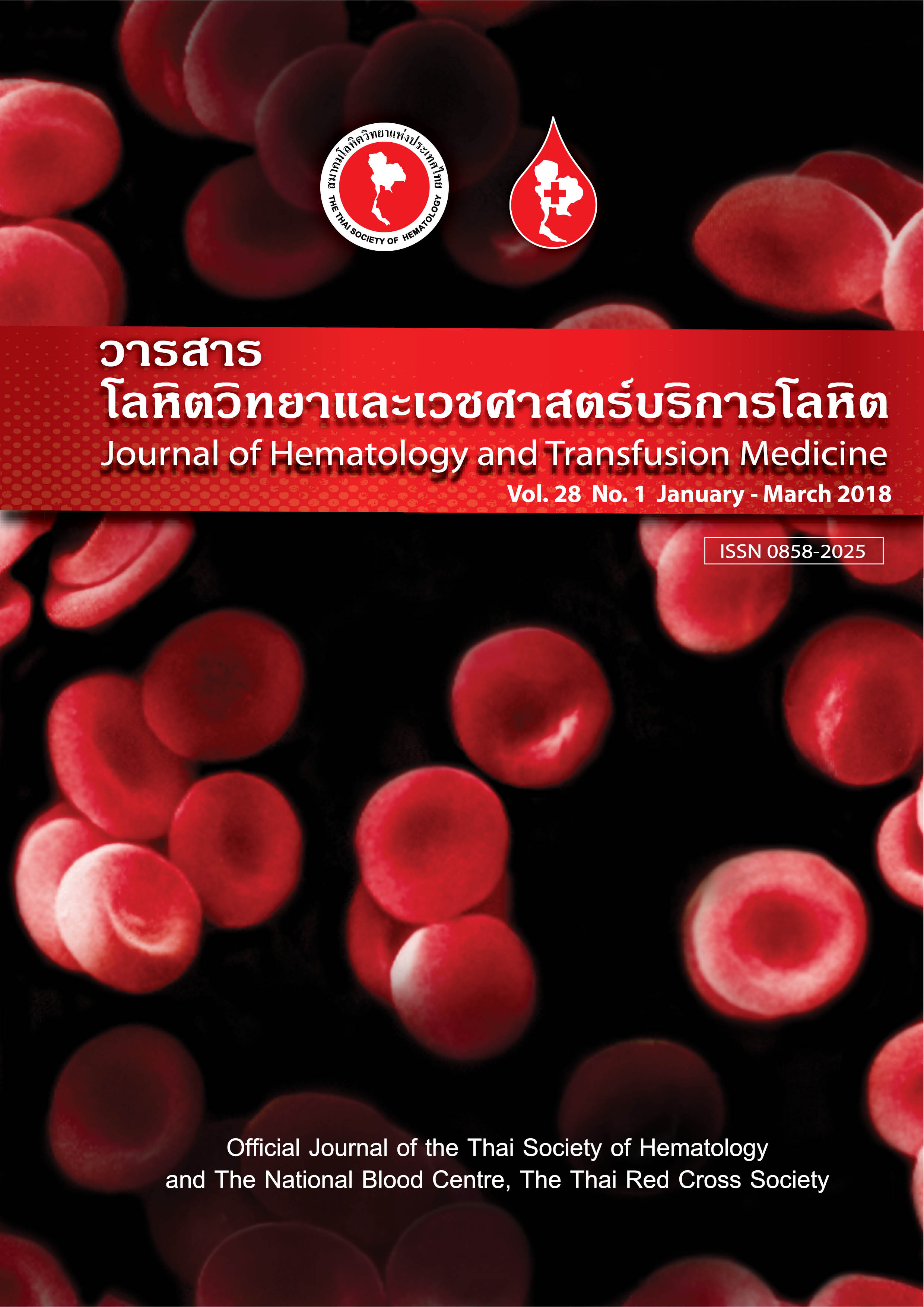Essential Composition of Blood Product: What is Different in a Unit of Red Cell Products ?
คำสำคัญ:
Red cell products, Quality control, Product variabilityบทคัดย่อ
Abstract:
Background: Blood products are considered as “ drug” but there are variations in the production process. So different types of red cell products have different characters. Objective: To compare the composition of red blood cell products from different whole blood volume and preparation methods and provide information for doctor to use products properly. Materials and Methods: We measure volume, total hemoglobin, number of white cells in 77-200 units of each type of red cell product from 450 and 350 whole blood collection, red cells separate by platelet rich plasma and buffy coat method and compare between them. Result: Total hemoglobin was 63 g for 450 ml and 45 g for 350 ml whole blood collection (p< 0.0001). Red cells separated by platelet rich plasma methods contain average 63 g total hemoglobin and white cell about 3 x 109 cells in both packed red cells (PRC) (270 ml volume) and red cell in additive solution (AS RC) (volume 350 ml). The leukocyte poor red cells produced by buffy coat method contain only 47 g total hemoglobin and white cells 0.8 x 109 cells (volume of 262 ml). Leuko-depleted filtration of AS RC and LPB lower white cell to 0.09 x 106cells, 0.05 x 106 cells/unit while containing 63 g and 47 g of hemoglobin, respectively (p< 0.0001). Conclusion: There is significant less total hemoglobin in 350 ml whole blood collection than 450 ml whole blood collection. Red cells from PRP method had significantly higher Hb (63 g vs 47 g) and white cells (3.0 cells vs 0.8 x 109 cells) than red cells from buffy coat production. Leuko-depleted filtration of red cells can lower white cell to less than 1 x 106 cells but with different amount of Hb in the final product.
บทคัดย่อ
บทนำ ส่วนประกอบของเลือดเปรียบเสมือน“ยา”ที่ใช้ในการรักษา แต่การผลิตส่วนประกอบของเลือดมีความหลากหลายทำให้ได้ผลิตภัณฑ์เม็ดเลือดแดงชนิดต่างๆที่มีคุณสมบัติแตกต่างกัน วัตถุประสงค์ เพื่อศึกษาเปรียบเทียบองค์ประกอบในผลิตภัณฑ์เม็ดเลือดแดงที่ได้จากปริมาณเลือดบริจาคและวิธีการเตรียมที่แตกต่างกัน เพื่อให้ข้อมูลแก่แพทย์ในการเลือกใช้อย่างเหมาะสม วัสดุและวิธีการ ทำการวัดและเปรียบเทียบ ปริมาตร ปริมาณ hemoglobin (Hb) และจำนวนเม็ดเลือดขาวในผลิตภัณฑ์เม็ดเลือดแดงชนิดต่างๆ ผลการศึกษา Whole blood(WB) จากเลือด 450 มล และ 350 มล มีปริมาณ Hb 63 กรัม และ 45 กรัม (p< 0.0001) Packed red cells(PRC) และ Red cell in additive solution (AS RC) ที่ผลิตจากเลือด 450 มล มีปริมาณ Hb และเม็ดเลือดขาวไม่แตกต่างกัน (Hb 63 กรัม เม็ดเลือดขาว 3x109 cells) แต่มีปริมาตรต่อหนึ่งยูนิตที่แตกต่างกัน (PRC 270 มล, AS RC 350 มล) Leukocyte poor blood (LPB) มีปริมาณ Hb 47 กรัม และเม็ดเลือดขาว 0.8x109 cells ซึ่งน้อยกว่า PRC และ AS RC (p< 0.0001) AS RC และ LPB ที่ผ่านการกรองเม็ดเลือดขาวออกจะเหลือเม็ดเลือดขาว 0.09x106 และ 0.05x106 cell โดยมีปริมาณ Hb 63 กรัม และ 47 กรัม ตามลำดับ (p<0.0001) สรุป เลือดบริจาค 450 มล และ 350 มล มีปริมาณ Hb ที่แตกต่างกัน ผลิตภัณฑ์เม็ดเลือดแดงที่เตรียมโดยวิธี platelet rich plasma (PRP) กล่าวคือ PRC และ AS RC มีปริมาณ Hb และ เม็ดเลือดขาวสูงกว่า LPB ซึ่งเตรียมโดยวิธี buffy coat อย่างมีนัยสำคัญ การกรองเม็ดเลือดขาวออกสามารถลดปริมาณเม็ดเลือดขาวได้เหลือน้อยกว่า 1x106 cells โดยไม่มีการเสียเม็ดเลือดแดงเพิ่มเติม



